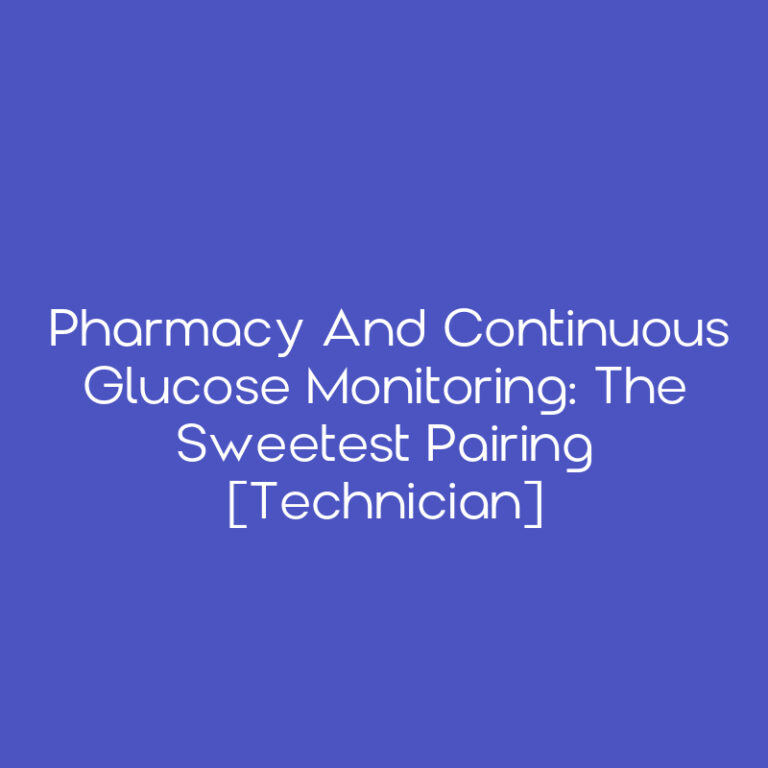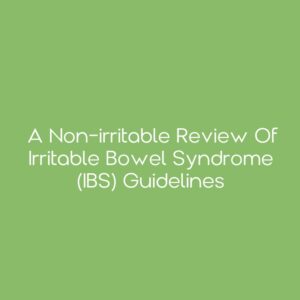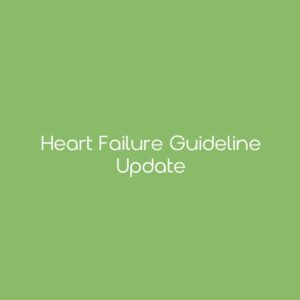Pharmacy and Continuous Glucose Monitoring: The Sweetest Pairing [Technician]

Pharmacy and Continuous Glucose Monitoring: The Sweetest Pairing [Technician]
The CGM course comprises six comprehensive modules designed to equip pharmacy professionals with essential skills and knowledge to successfully integrate CGM services into their pharmacy. Content includes an in-depth understanding of CGM technology and its benefits, ways to tailor management of suitable candidates for CGM use, practical steps for integrating a CGM service into pharmacy practice, tools and techniques for managing CGM patients remotely, and how CGMs can monitor the impact of nutrition, weight management, physical activity, and wellness activities. Learners will be empowered to develop a sustainable service to improve health outcomes for patients with and without diabetes.
Upon successful completion of this application-based CPE course, pharmacy technicians should be able to:
Module 1
1. Describe current recommendations for the utilization of continuous glucose monitoring (CGM) devices and their significance in diabetes management
2. Review CGM device components and their functionalities to ensure accurate data collection
3. Discuss the pros and cons of CGM technology for glycemic management
4. Recognize the metrics provided by CGM devices and their significance in managing diabetes
5. Examine patterns and trends in CGM graphs and reports to assist the pharmacist in making informed decisions regarding glucose management
Module 2
1. Compare and contrast commonly available CGMs, including features and capabilities
2. Evaluate criteria for selecting patients suitable for CGM use in various demographic and health populations
3. Explain the process of initiating CGM therapy in patients
4. Discuss common CGM issues to ensure continuous and reliable monitoring
5. Support the pharmacist in developing personalized diabetes management plans based on CGM data
Module 3
1. Discuss the impact of CGM service implementation on patient outcomes and healthcare resource utilization
2. Recognize motivators and barriers to implementing a CGM service in the pharmacy
3. Describe procedures for integrating CGM data into routine workflows, including documentation, data review, and collaboration with multidisciplinary care teams
4. Create an action plan to develop, initiate, and implement a CGM service in the pharmacy
Module 4
1. Describe the key components, technology, and processes involved in remote patient monitoring (RPM)
2. Identify patient criteria for a successful RPM program
3. Review how CGM integrates with telehealth visits and RPM
4. Recognize the role of pharmacy technicians in facilitating patient-provider communication using CGM data
5. Examine a patient case involving the utilization of CGMs in remote patient monitoring
Module 5
1. Review the relationship between dietary patterns, insulin sensitivity, weight management, and metabolic health
2. Recognize the role of CGMs in providing real-time feedback on the glycemic response to different foods
3. List strategies for optimizing meal timing, macronutrient composition, portion sizes, and meal spacing to minimize glycemic variability
4. Examine CGM data to assist the pharmacist in identifying patterns of glucose excursions related to specific dietary habits
5. Support the pharmacist in recommending nutrition and weight management interventions guided by CGM data in a case scenario
Module 6
1. Review the physiological benefits of physical activity and exercise on the body, including glucose metabolism
2. Define the fundamental principles of exercise and increased physical activity, including parameters such as frequency, intensity, duration, and
types
3. Recognize the value of incorporating exercise into the diabetes patient lifestyle to optimize blood glucose control
4. Compare strategies for managing blood glucose levels before, during, and after exercise based on CGM data
5. Support the pharmacist in recommending appropriate exercise interventions guided by CGM data in a patient case
Module 7
1. Explain the importance of integrating physical, emotional, and mental well-being into daily routines
2. Support the pharmacist in recommending wellness strategies tailored to individual needs and preferences using CGM data
Christie Schumacher, PharmD, BCPS, BCACP, BCCP, BCADM, CDCES, FCCP
Professor, Pharmacy Practice and Director, PGY2 Ambulatory Care
Residency Program
Midwestern University College of Pharmacy
Jennifer N. Clements, PharmD, FCCP, FADCES, BCPS, CDCES, BCACP, BC-ADM
Clinical Professor and Director of Pharmacy Education
University of South Carolina College of Pharmacy
Bianca Daisy-Bell, PharmD, BCACP
Director of Clinical Pharmacy Services
SEMO Rx
Nicole Gorsuch, PharmD
PGY1 Pharmacy Resident
L&S Pharmacy
Bridget Dolan Teschke, PharmD, BCACP
Clinical Pharmacist
Northwestern Medicine
Amy Wainright, PharmD, BCACP, BCGP
Clinical Pharmacist Specialist
University Of Chicago Medicine
Lyndi Mies, MHSc, RDN, LDN
Senior Clinical Regional Dietitian
Weis Markets, Inc.
Kelly Sklanka, PharmD, CDCES
Assistant Professor of Pharmacy Practice
Wilkes University Nesbitt School of Pharmacy
Mark Smith, PharmD, CDCES
Pharmacist
UAB Hospital
Ian Haywood, PharmD, BCPS, CDCES
Clinical Pharmacist
Baptist Memorial Hospital
Bela Patel, PharmD, NBHWC
Founder and Pharmacist Health coach
Wholistic Pharmacist
Bianca Daisy-Bell, Nicole Gorsuch, Bridget Dolan Teschke, Amy Wainright, Lyndi Mies, Kelly Sklanka, Mark Smith, Ian Haywood, and Bela Patel have no relevant financial relationships with ineligible companies to disclose.
Christie Schumacher is on the advisory board for Novo Nordisk and the speaker’s bureau for Abbott. All relevant financial relationships have been mitigated.
Jennifer Clements is on the speaker’s bureau for NovoNordisk and Eli Lilly and previous board member for Embecta, as well as a consultant for Xeris Pharmaceuticals. All relevant financial relationships have been mitigated.
Financial support was provided for this course through an unrestricted educational grant from Abbott Diabetes Care.
Course fee includes course, course materials, and CPE credit submission to CPE Monitor.
Course is non-refundable.
Initial Release Date: June 1, 2024
Planned Expiration Date: June 1, 2027
Copyright 2024, CEimpact. All Rights Reserved. Any reproduction of this course without express permission is strictly forbidden.
![]() CEImpact is accredited by the Accreditation Council for Pharmacy Education as a provider of continuing pharmacy education. Obtain CPE credit by completing the course, followed by the exam and evaluation (if applicable). Once successfully completed, your course will appear in your Completed Courses tab. Access your CPE statement of credit at www.MyCPEMonitor.net.
CEImpact is accredited by the Accreditation Council for Pharmacy Education as a provider of continuing pharmacy education. Obtain CPE credit by completing the course, followed by the exam and evaluation (if applicable). Once successfully completed, your course will appear in your Completed Courses tab. Access your CPE statement of credit at www.MyCPEMonitor.net.
¹CEImpact provides you with two (2) opportunities to complete the exam. The learner will not receive CPE credit after two failed attempts.
Additional information
| Duration | 6h 30m |
|---|---|
| Topic Designator | Disease State/Drug Therapy |
| ACPE | Yes |
| ACPE Topic | 01 Drug Therapy |
| Role | Technician |
| Media-Type | On-Demand |
| Release Date | 6/1/24 |
| CEUs | 0.65 |
| Rating | 5 |
| ACPE Number | 0107-0000-24-135-H01-T |



![Advances in ADHD Treatment [Pharmacist]](https://www.ceimpact.com/wp-content/uploads/course-images-solidbg/2022/06/pharmacist/4547-300x300.jpg)
